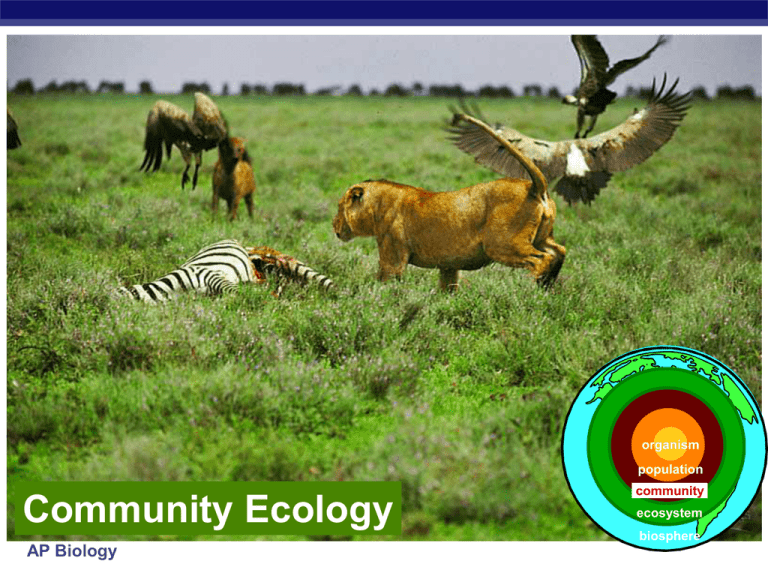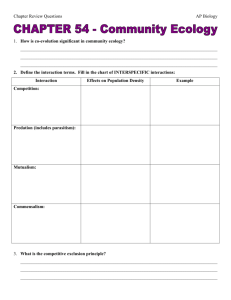Community Ecology AP Biology organism population
advertisement

organism
population
Community Ecology
community
ecosystem
biosphere
AP Biology
Community Ecology
Community
all the organisms that live together in a
place
interactions
Community Ecology
AP Biology
study of
interactions
among all
populations
in a common
environment
To answer:
In what way do the
populations interact?
Niche
An organism’s niche is its ecological role
habitat = address vs. niche = job
High tide
Competitive Exclusion
If Species 2 is removed,
then Species 1 will occupy
Low tide
whole tidal zone.
But at
lower depths Species 2
out-competes Species 1,
excluding it from its
potential (fundamental)
niche.
AP Biology
Species 1
Chthamalus sp.
Species 2
Fundamental Realized
niches
niches
Semibalanus sp.
Niche & competition
Competitive Exclusion
AP Biology
No two similar species can occupy the
same niche at the same time
Resource partitioning
Reduce competition through microhabitats
“the ghost of
competition past”
AP Biology
Interspecific interactions
Symbiotic interactions
competition (-/-)
compete for limited resource
competitive exclusion!
predation / parasitism (-/+)
mutualism (+/+)
lichens (algae & fungus)
commensalism (+/0)
barnacles attached
to whale
AP Biology
Symbiosis
mutualism
+/+
…not very funny
for a clown fish
commensalism
+/0
predation
+/- competition
AP Biology
-/-
What relationship is this?
AP Biology
Predation drives evolution
Predators adaptations
locate & subdue prey
Prey adaptations
elude & defend Predation provides
horns, speed, coloration
a strong selection
pressure on both
prey & predator
spines, thorns, toxins
AP Biology
Anti-predator adaptations
Hide from predators
avoid detection
camouflage
Warn predators
advertise how undesirable
you are as prey
aposematic coloration
apo = away & sematic = sign/meaning
Batesian mimicry
Mullerian mimicry
AP Biology
Defense mechanisms
Camouflage
cryptic coloration
whipporwill
frog
lizard
lizard
AP Biology
toad
Convergent evolution
Mimicry
Batesian mimicry
palatable or harmless species
mimics a harmful model
green parrot snake
hawkmoth larvae
AP Biology
Hawkmoth larva puffs up to
look like poisonous snake
Convergent evolution
Batesian mimicry
Monarch male
Viceroy male
poisonous
edible
Which is the moth
bee?
fly vs.vs.
thethe
bee?
AP Biology
fly
bee
moth
bee
Mullerian mimicry
two or more protected
species look like each other
cuckoo bee
yellow jacket
AP Biology
- group defense?
Mullerian mimicry
- predators may evolve innate avoidance
Common warning coloration
Aposematic species come to resemble each other
black, red,
orange & yellow
means:
DON’T EAT ME!
AP Biology
What kind of mimicry?
Coral snake
is poisonous
King snake is not
Red on yellow, poison fellow;
red on black, safe from attack
AP Biology
Coevolution in Community
Predator-prey relationships
Parasite-host relationships
Flowers & pollinators
Long term evolutionary adjustments between species
AP Biology
Characterizing a community
Community structure
species diversity
how many different species
composition
dominant species
most abundant species
or highest biomass
(total weight)
keystone species
changes over time
succession
AP Biology
Species diversity
greater diversity = greater stability
Greater biodiversity
offers:
more food
resources
more habitats
more resilience
in face of
environmental
change
AP Biology
The impact of reduced biodiversity
compare these communities
suburban
lawn
agricultural
“monoculture”
AP Biology
“old field”
Irish potato famine
1970 US corn crop failure
Keystone species
Pisaster ochraceous
Influential ecological role
exert important
regulating effect
on other species
in community
keystone
species
increases
diversity
in habitat
AP Biology
Washington coast
Sea star
diversity increases
diversity decreases
mussels out-compete
other species
Keystone species
Sea otter is a
keystone
predator in
North Pacific
What is the
impact of the
Orca whale?
AP Biology
Keystone species
Beaver is a
keystone species in
Northeast & West
dams
transform flowing streams into ponds creating new habitat
AP Biology
Ecological succession
Sequence of community changes
transition in species composition over time
years or decades
usually after a disturbance
Mt.
Helens
AP St.
Biology
Primary succession
Begins with
virtually
lifeless area
without soil,
then…
bacteria
lichens &
mosses
grasses
shrubs
trees
{
make
soil
AP Biology
Secondary succession
Existing community cleared,
but base soil is still intact
burning releases
nutrients formerly
locked up in the
tissues of tree
the disturbance
starts the process
of succession
over again
AP Biology
Succession of species
pioneer species
lichens & mosses
more shade tolerant species
AP Biology
bushes & small trees
compete well in high sunlight
grasses
climax forest
shade tolerant species
stable community
trees
What causes succession?
Tolerance
early species are weedy r-selected
tolerant of harsh conditions
Facilitation & Inhibition
early species facilitate habitat changes
change soil pH
change soil fertility
change light levels
AP Biology
allows other species
to out-compete
Climax forest
Plant community dominated by trees
Representing final stage of natural
succession for specific location
AP Biology
stable plant community
remains essentially unchanged in species
composition as long as site remains undisturbed
birch, beech, maple,
hemlock
oak, hickory, pine
Climax forest
taiga
The species mix of
climax forest is
dependent on the
abiotic factors of
the region
solar energy levels
temperature
rainfall
fertility & depth of soil
AP Biology
temperate deciduous forest
birch, beech, maple, hemlock
Disturbances as natural cycle
Disturbances are often necessary for
community development & survival
- release nutrients
- increases biodiversity
fire climax forests
AP Biology
- increases habitats
- rejuvenates community
Fire climax species
adaptations to survive
and reproduce in areas
than experience
frequent fires
AP Biology
Jack Pine
When people don’t learn ecology!
Building homes in fire climax zones
preventing fires
makes next year’s
fire much worse!
AP Biology
Don’t blow
your top!
Ask
Questions!
AP Biology
2007-2008





